Lisbon is one of the oldest capitals of Europe, but it also has some remarkable modern and contemporary architecture. Below is a quick guide to Lisbon’s most interesting modern buildings.
Many of Lisbon’s contemporary structures were built for the World Fair Expo 98, and are located in the Parque das Nações district.
This event caused a construction boom in Lisbon. It propelled the economy of Lisbon for years to come, much like hosting the Olympics did for Barcelona in 1992.
Surprisingly, you will also find several of Lisbon’s most contemporary buildings in one of Lisbon’s oldest neighborhoods – Belém, where you find the Belém Tower (built in 1514) and the Jerónimos Monastery (built in 1501).
We will start in Parque das Nações.
Centro Vasco da Gama / Oriente Station
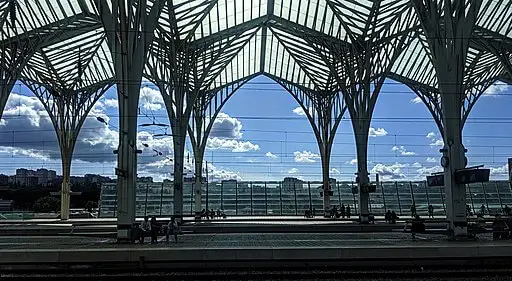
This transportation hub is the gateway to Parque das Nações.
The Oriente Station by Santiago Calatrava was commissioned in 1994 as a way to move World Fair Expo ‘98 visitors to Parque das Nações.
The station has two levels.
The upper level has tracks for the Comboios national train network.
The lower level is for the Lisbon subway network’s red line.
There is also a bus station for the local and intercity buses.
Adjacent to the station is the Vasco da Gama Shopping Mall.
For more information on Lisbon’s shopping malls, see my article, Where to shop in Lisbon? Lisbon’s best malls and shopping
For information on historical, family-owned shops in Lisbon, see Lisbon’s historical family-owned stores and craftsmen sell the best souvenirs
Lisbon Casino
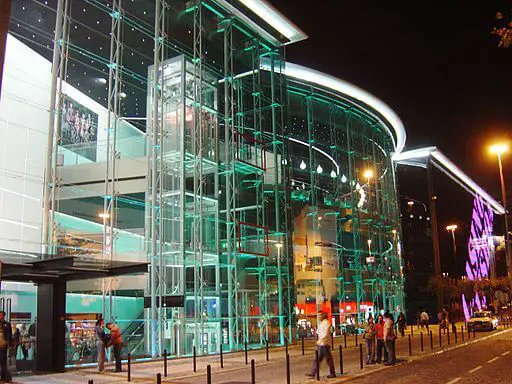
Alameda dos Oceanos 45, Parque das Nações.
Metro: Red line, Oriente Station
Buses: 705, 725, 728, 744, 708, 750, 759, 782, 794
Hours: 2p – 2 am
Casino Lisboa (casino-lisboa.pt)
Originally, the building that is today the Lisbon Casino was the Pavilhao do Futuro (Pavilion of the Future) at Expo ‘98.
It was created by architects Ana Paula Lopes dos Santos, Miguel Ferreira Guedes de Carvalho and Rui Jorge Garcia Ramos.
The building was updated by architect Fernando Jorge Correia.
Architects Stanley Ho, Teddy Yip, Yip Hon, and Teddy Fok oversaw the final redesign, and the casino opened in 2006.
Torre Vasco da Gama
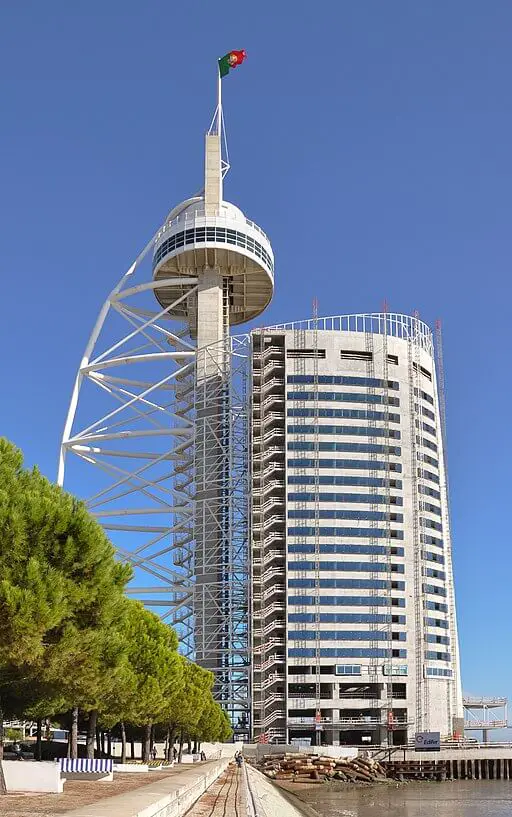
Cais das Naus, Lote 2, Parque das Nações
Metro: Oriente (red line)
Built for the World Fair Expo ‘98, like the rest of the Parque das Nações “campus.”
1998 also coincided with the 500th anniversary of Vasco da Gama’s voyage to India.
Architects who worked on the design and construction include Leonor Janeiro, Nick Jacobs, and the firm SOM (Skidmore, Owings, and Merrill).
The architects were inspired by Vasco da Gama’s caravel ship.
The base of the building sits in the water, and then the tower resembles a mast with a sail, and the observation deck. The viewing deck finally reopened to the public on May 22, 2023.Vasco da Gama Tower – Lisbon’s newest viewpoint is now open
It is the tallest building in Lisbon at 476 feet.
The lattice tower and skyscraper are now owned by the Myriad by SANA Hotel. Hotel MYRIAD by SANA | 5 Stars Luxury Hotel in Lisbon | Portugal
You can eat in the River Lounge on the bottom floor.
You can also enjoy the telecabine aerial cablecar, which runs from the tower to the Oceanarium at the other end.
Telecabine Elevated Cablecar
Passeio das Tagides 1900, Doca dos Olivais, in Parque das Nações
Metro: Red line, Oriente Station
Buses: 705, 725, 728, 744, 708, 750, 759, 782, 794
This gondola lift is located between two buildings on our list – the Torre de Vasco da Gama and the Oceanário.
You can board the Telecabine Lisboa (Lisbon Gondola Lift) right next door to the Oceanarium at the Passeio de Neptuno South Station, or the Passeio de Tágides North Station.
Adult tickets are 4.50 euros one way, 6.50 euros round trip. Children 4 – 12 are 3 euros one way, 4.50 euros round trip.
You can also buy a discounted combination ticket for the aquarium and telecabine at this link
Telecabin Lisbon – Parque das Nações (telecabinelisboa.pt)
Oceanário de Lisboa
Esplanada Dom Carlos, Doca dos Olivais, in Parque das Nações
Metro: Red line, Oriente Station
Buses: 705, 725, 728, 744, 708, 750, 759, 782, 794
Hours: Summer 10 am – 8 pm, Winter 10 am – 7 pm
Admission: Ages 0 -3 free, ages 4 – 12 10 pay euros, ages 12 – 64 19 pay euros, 65+ 13 euros
The building was designed by architect Peter Chermayeff.
Lisbon’s oceanarium is built on a pier in a man-made lagoon.
It resembles an aircraft carrier or a drilling platform.
The aquarium opened in 1998.
The exhibits are organized around a 180,000 cubic ft. central tank.
This tank replicates the open ocean and houses 100 species from around the world.
Then there are four other tanks representing different habitats.
With 450 marine species and more than 16000 animals, it is the largest aquarium in Europe.
For more information on the oceanarium, see my article Lisbon Oceanarium | Plan Your Visit to the Oceanário de Lisboa
Altice Arena
Rossio dos Olivais, Lote 2, Parque das Nações
Metro: Oriente (red line)
This was Portugal’s first large multipurpose room, capable of hosting and broadcasting indoor concerts and sporting events.
It was built from 1996 – 1998 under the direction of architect Regino Cruz and SOM (Skidmore, Owings, and Merrill)
Both were also involved in planning the Torre Vasco da Gama.
SOM has won first prize in architectural contests with its arenas in Manchester and Berlin and has also designed arenas in
Portland, Philadelphia, Oakland, and Minneapolis.
One of the focuses of the building is to provide high levels of comfort while using low energy consumption.
The air conditioning system operates with 100% use of exterior air.
In the summer water from the river is used to pre-cool the air. In the winter thermal energy is used.
Feira Internacional de Lisboa (FIL)
Rua do Bojador 1998, Parque das Nações
Latitude – 38.76974416 Longitude – 9.09485579
Metro: Red line, Oriente Station
Buses: 705, 725, 728, 744, 708, 750, 759, 782, 794
Hours: 8:30 am – 11 pm
This building is the largest conference and convention center in Portugal, and possibly the entire Iberian Peninsula.
The size of eleven football fields, the venue holds dog shows, motorcycle shows, arts and crafts fairs, Christmas fairs, design shows, and various industry and trade shows throughout the year.
Fil – Lisbon International Fair
Portugal Pavilion
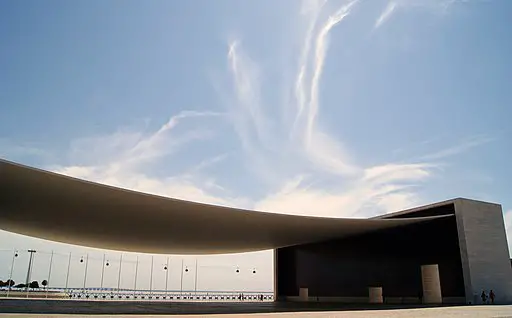
Doca dos Olivais, Parque das Nações.
Metro: Red line, Oriente Station
Buses: 705, 725, 728, 744, 708, 750, 759, 782, 794
The Portugal Pavilion at Parque das Nações was designed by award-winning Portuguese architect Alvaro Siza Vieira.
It was designed to be the entry gate at Expo Park in 1998.
His building is known for its sagging roof over the ceremonial courtyard, which resembles a piece of hanging, sagging fabric.
The roof weighs 1400 tons and measures 167 ft. by 223 ft.
It is currently an exhibition hall that belongs to the University of Lisbon.
São Gabriel and São Rafael Towers
Torre São Gabriel on Avenida do Pacifico, Vasco da Gama Centre Apartments I is 361 feet tall.
It has 24 floors above ground and 5 below ground.
The building was completed in 2000, four years before its twin.
Torre São Rafael is also known as Vasco da Gama Centre Apartments II.
It is 361 feet tall, with 24 floors above ground and 5 below ground.
Built in 2004 at the corner of Almeda dos Oceanos and Avenida do Índico, it is a residential building.
Vasco da Gama Bridge
Metro: Moscavide or Oriente stations, both on the red line
Also built in 1998, the 56,430 foot (more than ten miles) long bridge is the longest bridge in Europe.
It connects Lisbon and northern Portugal to southern Portugal.
On the Lisbon side, you will find Parque do Tejo, and a skate park under the bridge.
There is also a boardwalk that parallels the bridge.
The Vasco da Gama Bridge was built to alleviate traffic from the 25 April Bridge on the western side of Lisbon.
Construction began in 1995, and the bridge opened in 1998.
It is a six-lane toll road with maximum speeds of 75 mph.
MAAT Museum of Art, Architecture, and Technology
Avenida Brasilia, Central Tejo (east of Belém)
Latitude 38º41’44.52 N, Longitude 9º11’44.30 W
Bus 201, 714, 727, 751 – Altinho, Tram 15E, 18E – Altinho Stop (MAAT)
Train from Cais do Sodré to Belém Station (Cascais Line)
Closed Tuesdays, Open 11 am – 7 pm Wednesday – Monday. From June – September open til 10 pm on Friday and Saturday nights
Admission 9 euros adults, Children over 12 pay 7.20 euros, seniors 6 euros.
Prices are lower this summer. There is also a family discount.
The museum incorporates two buildings, one old, one new. Both parts are very visually appealing.
First, there is the old brick Tejo Power Station, Portugal’s first power plant.
It later became the Museum of Electricity.
It is connected to a gleaming white building that is shaped like a wave. The new building opened in 2016.
Today the MAAT focuses on the past, present, and future of energy.
Exhibits also include works by modern Portuguese artists and photographers.
For more information, see my article Visit Lisbon’s Museum of Art, Architecture, and Technology (MAAT)
Museu Berardo
Praça do Império 1449, Belém
Take Tram 15 to Praça do Império, Belém. Or take bus 714 from Praca da Figueira.
GPS +38.695533, -9.209288, N 38º 41′ 47.71” / W 9º 12′ 26.78”
The museum is free on Saturdays. Open every day from 10 am – 7 pm.
Museu Coleção Berardo | Lisbon (museuberardo.pt)
This private collection is the premiere gallery of contemporary art in Portugal.
It includes pieces by Dalí, Picasso, and Andy Warhol.
The collection is located in the exhibition hall of the Centro Cultural de Belém.
The Centro Cultural de Belém was built between 1989 – 1992 under the direction of architects Vittori Gregotti and Manuel Salgado.
The Belém Cultural Center won the International Stone Architecture Award at the Verona Fair in 1993.
Museu dos Coches (Carriages Museum)
Praca Afonso de Albuquerque 1300, Belém
Homepage (museudoscoches.gov.pt)
Train from Cais do Sodre to Belem Station or take bus 28, 714, 727, 729, 751, or take Tram 15
Hours: 10 am – 5:30 pm. Closed on Mondays. Admission is 8 euros
The museum exhibits a collection of royal carriages and private horse-drawn carriages that were used from the 16th century until the 19th century.
The white concrete building was designed by Brazil’s Pritzker Prize architect Paulo Mendes da Rocha.
Fundação Champalimaud
Avenida Brasilia 1400, Belém
Homepage | Champalimaud Foundation (fchampalimaud.org)
Built under the direction of Indian architect Charles Correa, the building is located on the riverbank near the mouth of the Tejo River, where the great Portuguese explorers launched their boats.
Today, modern Portuguese explorers are looking to launch new discoveries in the field of cancer research from the same piece of land.
The Champalimaud Foundation is a leader in biomedical research.
Ground was broken on the project in 2008.
Maritime Control Tower
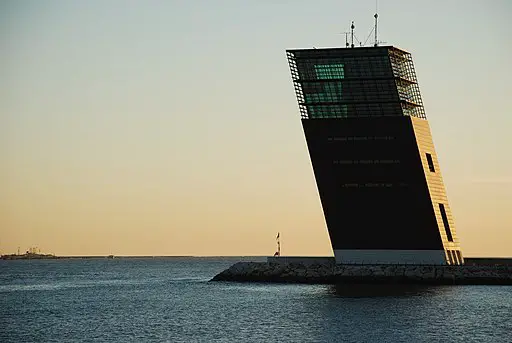
Located in Belém, this might be the coolest modern structure in Lisbon, although it is not open to the public.
This leaning, or slanted tower, is the radar and radio control tower for all of the water traffic in the port of Lisbon and on the Tagus River.
The base of the tower is stone, then the middle section is copper paneling, and the top section is all glass, and lights up at night like a lighthouse.
Designed by Gonzalo Byrne, the Centro de Coordenacáo e Controlo de Tráfego Maritimo e Seguranca was completed in 2001.
The 124-foot tower is located on a spit of land and hangs out over the water at 38° 41′ 38.49″ N 9° 14′ 3.55″ W.
In order to find it, continue west past the Torre de Belém and the Fundação Champalimaud on Avenida Marginal.
Calouste Gulbenkian Museum
Avenida de Berna 45
Metro: São Sebastião (blue or red lines), or bus 716, 726, 756
Hours: 10 am – 5:30 pm
Admission: 10 euros
The private collection of oil magnate, Calouste Gulbenkian is one of the largest collections of art in the world.
The collection includes pieces by Rubins, Rembrandt, Rodin, Monet, and many others, as well as pieces of ancient art.
Calouste Gulbenkian Foundation
Estadio da Luz
Metro: Luz
Built in 2003 at a cost of 118 million euros, the stadium is the home of Liga Nos Football champion SL Benfica. The stadium seats 64,000.
Tours of the stadium are possible. Museum and Stadium Tour – SL Benfica
Monsanto Tower
This 394-foot tall building is the second tallest in Portugal.
It has 20 floors.
Located in the Oeiras neighborhood, Monsanto Tower was built in 2001 by Architect Sua Kay.
It is a commercial office building.
Edificio FPM 41
Avenida Fontes Pereira de Melo 41
Also known as the Torre Picoas, the FPM Building has 17 floors above ground (six floors below ground) and is 229 feet tall.
It was built between 2015 and 2018 by Barbas Lopes Architects.
Modern architectural tours in Lisbon
If you want to learn more about Lisbon’s modern architecture (as well as the centuries-old buildings), don’t hesitate to hire an expert in the field to show you around.
Consider one of these three tours.
Contemporary Architecture and Art in Lisbon – Episode Travel (episode-travel.com)
Another option is Contemporary architecture in Lisbon (lisboaarchitecturewalkstrips.com) or also LISBON TOUR – Lisbon Contemporary Architecture (toptour.pt)
Please know that I am not affiliated with any of the businesses listed on this page.
Conclusion
Lisbon is a city famous for its old architecture, but it also has several modern classics by award-winning architects as well, particularly in the Parque das Nações and Belém neighborhoods.
Other contemporary public buildings can be found around the city, as well as private homes built in a modern style.
If you are also interested in seeing the centuries-old buildings that make Lisbon famous, check out this article, The oldest buildings you can still see in Lisbon